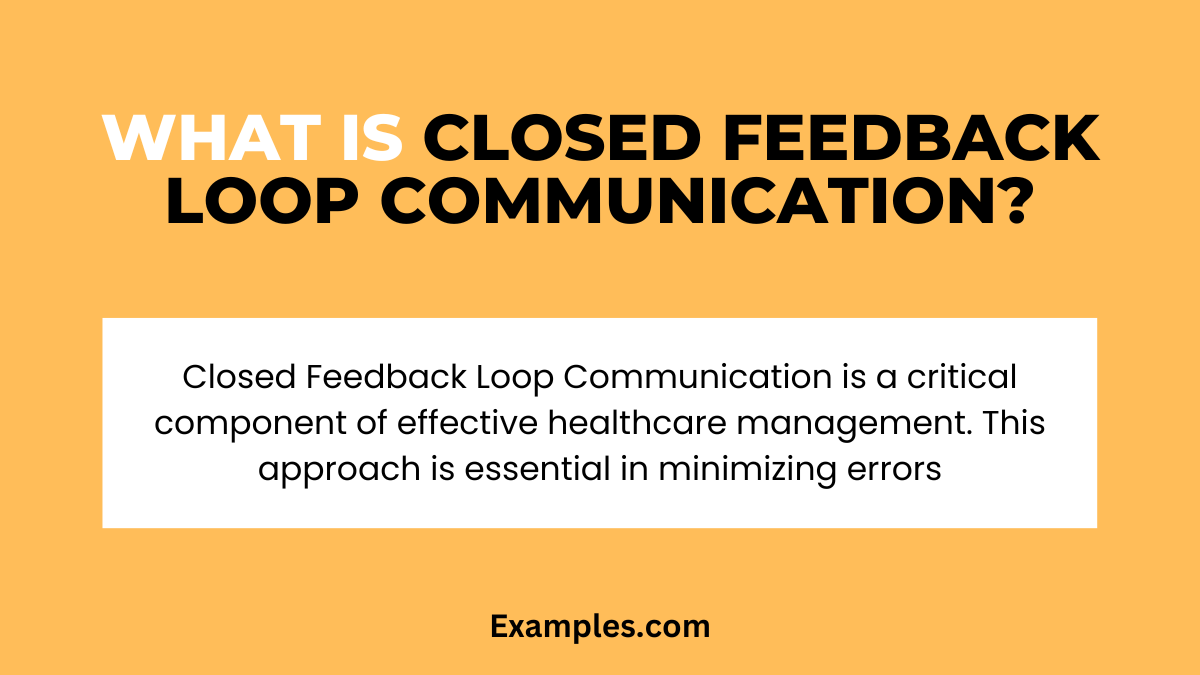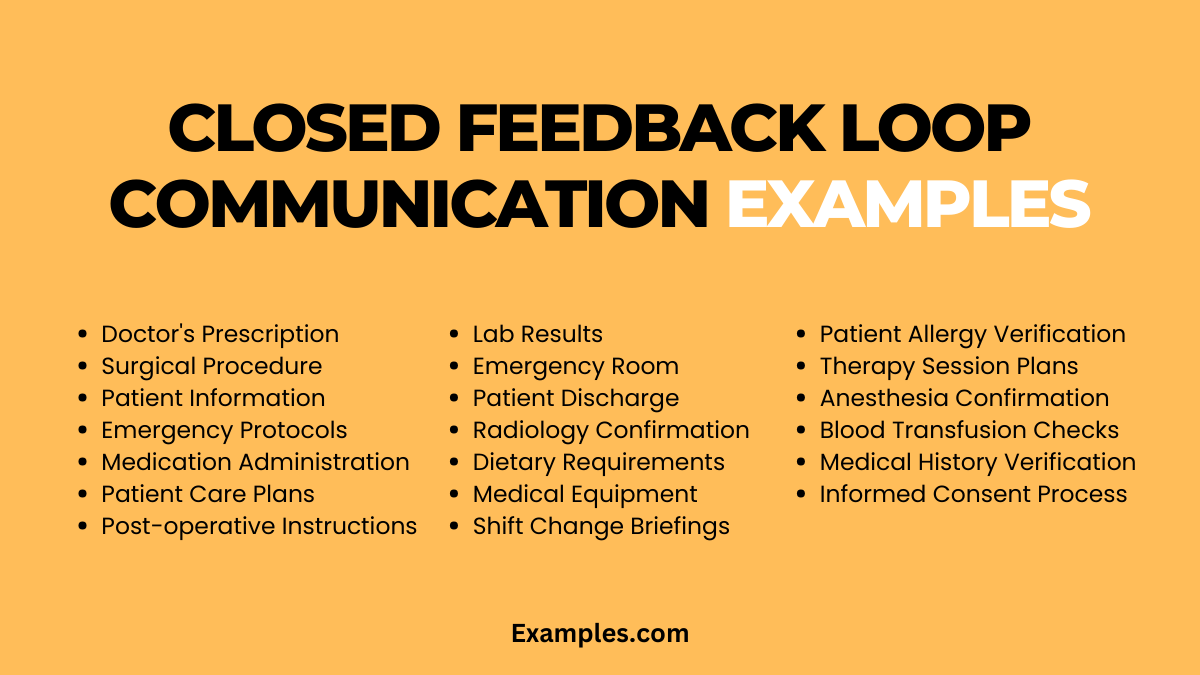19+ Closed Feedback Loop Communication Examples
Closed Feedback Loop Communication is a pivotal element in enhancing patient care and healthcare efficiency. This guide delves into the nuances of this critical communication strategy, illustrating with real-world examples. By focusing on essential actions for Closed Loop Communication, the guide illuminates how healthcare professionals can ensure accurate information exchange, enhance patient safety, and foster effective teamwork. Understanding and implementing these principles is crucial for any healthcare setting, providing a roadmap to better patient outcomes and streamlined medical processes.
What is Closed Feedback Loop Communication? – Meaning

Closed Feedback Loop Communication is a critical component of effective healthcare management. It refers to a communication process where information is not only delivered but also confirmed and understood by the receiver. This method is integral in what is closed loop communication, ensuring that instructions and vital information are accurately received, understood, and acted upon. It often involves steps like delivering a message, seeking acknowledgment, and confirming understanding, forming a “loop” of communication. This approach is essential in minimizing errors, particularly in high-stakes environments like healthcare, where precise communication can significantly impact patient outcomes.
Download Closed Feedback Loop Communication Now in PDF
20 Closed Feedback Loop Communication Examples

Closed Loop Communication is essential in healthcare for ensuring clear, accurate exchanges of information for Closed Loop Communication Steps. This communication strategy involves steps where a message is sent, acknowledged, and then verified for comprehension. This method is crucial for preventing miscommunications, especially in critical healthcare settings.
- Doctor’s Prescription Confirmation: A nurse reads back a doctor’s prescription to confirm dosage and medication.
- Surgical Procedure Clarification: Before surgery, a surgeon repeats back a patient’s details and procedure for accuracy.
- Patient Transfer Information: When transferring a patient, nurses confirm and repeat back care details to the receiving nurse.
- Emergency Protocols: In emergencies, responders use closed loop communication to verify actions and instructions.
- Medication Administration: Nurses confirm with each other the type and dosage of medication before administration.
- Patient Care Plans: Healthcare teams discuss and confirm patient care plans, ensuring all members understand their roles.
- Post-operative Instructions: Surgeons provide post-operative care instructions, which nurses read back for clarity.
- Lab Results Communication: Lab technicians confirm and verify critical lab results with physicians through closed loop communication.
- Emergency Room Handoff: In emergency room handoffs, medical professionals confirm received information about incoming patients.
- Patient Discharge Instructions: Nurses read back discharge instructions to patients and their families for comprehension.
- Radiology Requests Confirmation: Radiologists confirm specific imaging requests from physicians to ensure correct procedures.
- Dietary Requirements Check: Dietitians repeat back patients’ dietary restrictions to nursing staff.
- Medical Equipment Usage: Healthcare staff confirm instructions on the use of specific medical equipment.
- Shift Change Briefings: During shift changes, nurses use closed loop communication to confirm patient status and care instructions.
- Patient Allergy Verification: Medical staff confirm and repeat back known patient allergies during treatment.
- Therapy Session Plans: Therapists confirm treatment plans with patients at the start of sessions.
- Anesthesia Plans Confirmation: Anesthesiologists use closed loop communication to confirm anesthesia plans with surgical teams.
- Blood Transfusion Checks: Before blood transfusions, medical staff confirm blood type and patient details.
- Medical History Verification: Doctors repeat back key elements of a patient’s medical history during consultations.
- Informed Consent Process: Healthcare providers confirm patient understanding of procedures during the informed consent process.
Why Closed Feedback Loop Communication is Important?
Closed Feedback Loop Communication is vital in healthcare for several reasons. It enhances patient safety by ensuring that medical instructions are clearly understood and accurately executed, reducing the risk of errors. This communication model is especially important in nursing, where Closed Loop Communication in Nursing ensures that patient care directives are conveyed precisely. It is a key component of effective patient care, promoting better outcomes and patient satisfaction. The Importance of Closed Loop Communication lies in its role in preventing miscommunication, a common cause of medical errors.
What is Closed Feedback Loop Communication Training in Medical Simulation?
Closed Feedback Loop Communication training in medical simulation involves practicing this crucial communication technique in a controlled, simulated medical environment. This training allows closed loop communication in healthcare professionals, especially nurses, to hone their communication skills, emphasizing the importance of clear message delivery, acknowledgment, clarification, and confirmation.
- Scenario-Based Learning: Trainees practice in simulated medical scenarios, enhancing their ability to apply closed loop communication effectively.
- Real-Time Feedback: Instructors provide immediate feedback on communication techniques during simulations.
- Debriefing Sessions: Post-simulation discussions focus on communication effectiveness and areas for improvement.
- Interprofessional Collaboration: Encourages teamwork across different medical professions, reflecting real-world settings.
- Continuous Assessment: Regular evaluation of communication skills to track progress and identify areas needing further training.
- Focus on Patient Safety: Training emphasizes the Importance of Closed Loop Communication in enhancing patient safety.
- Customized Learning: Tailors simulations to address specific communication challenges in different healthcare environments.
- Reinforcement of Best Practices: Reinforces the best practices in closed loop communication through repeated practice and feedback.
This training is crucial in preparing healthcare professionals for effective communication in real-life medical situations, ensuring the highest standards of patient care and safety.
How Feedback Changes The Closed Loop Communication?
Feedback significantly enhances Closed Loop Communication, particularly in healthcare settings. By integrating feedback, the communication process becomes more dynamic and responsive, allowing for real-time adjustments and improvements. This includes adapting messages based on the receiver’s understanding and incorporating their input to refine communication strategies. In Closed Loop Communication for Patients and Nurses, feedback ensures that patient care instructions are not only conveyed but also effectively acted upon, thus improving patient outcomes. In the broader context of Closed Loop Communication in Medical scenarios, incorporating feedback helps to identify areas needing improvement, leading to more effective patient care and safety protocols.
How to Build Closed Feedback Loop Communication?
Building a Closed Feedback Loop Communication system involves several key steps:
- Establish Clear Communication Channels: Set up defined channels for sending and receiving messages.
- Train Healthcare Professionals: Educate staff on the importance and methods of effective communication, including feedback mechanisms.
- Implement Patient Feedback Systems: Encourage patients to provide feedback on their care, enhancing the loop between patient and provider.
- Regularly Review and Adjust Protocols: Continuously evaluate communication processes and make necessary adjustments based on feedback.
- Encourage Open Dialogue: Foster an environment where feedback is openly given and received, enhancing mutual understanding.
- Document and Analyze Feedback: Keep records of feedback to track progress and identify trends.
- Promote Team Collaboration: Ensure that all team members, including patients, are involved in the communication loop.
By following these steps, healthcare providers can build an effective Closed Feedback Loop Communication system, enhancing the quality of care and ensuring patient safety.
Tips for Enhancing the Process of Closed-Loop Feedback Communication
- Establish Clear Protocols: Implement well-defined protocols for closed-loop communication, ensuring that every team member understands the process.
- Promote Active Listening: Encourage team members to practice active listening, a key component in effectively receiving and processing information.
- Foster Open Communication Culture: Create an environment where seeking clarifications and asking questions is encouraged, enhancing mutual understanding.
- Utilize Technology: Implement technological tools that support and streamline the closed-loop communication process.
- Regular Training and Simulation: Conduct training sessions and simulations to reinforce the importance and application of closed-loop communication in healthcare.
- Feedback Collection and Analysis: Collect feedback regularly to identify areas for improvement and apply the insights gained to enhance communication strategies.
- Adaptability: Be flexible and adapt communication strategies to suit different situations, especially in diverse healthcare settings.
- Understand Open Loop vs Closed Loop Communication: Recognize the differences and apply the appropriate method in various scenarios for better outcomes.
By implementing these strategies, healthcare professionals can significantly enhance the closed-loop feedback communication process, leading to improved patient care and safety.
Statistics Highlighting the Closed Feedback Loop Communication
Closed Feedback Loop Communication is a critical component in healthcare, particularly in nursing, where it significantly enhances patient safety and reduces medical errors. This communication strategy ensures that messages are not only delivered but also acknowledged, clarified, and confirmed. By implementing closed-loop communication systems, healthcare professionals can significantly improve the accuracy and effectiveness of their interactions, leading to better patient outcomes.
Closed Feedback Loop Communication in healthcare, particularly in nursing, plays a pivotal role in enhancing patient care and safety. This method involves a cyclical process of information exchange where clarity and understanding are paramount. The implementation of Closed Loop Communication systems in healthcare settings has been shown to significantly reduce misunderstandings and errors, ensuring that patient care instructions are precisely conveyed and understood. This approach not only improves patient outcomes but also enhances the overall efficiency and effectiveness of healthcare delivery.
For comprehensive information and statistics regarding the impact and effectiveness of Closed Feedback Loop Communication in healthcare, you can refer to resources available on the Agency for Healthcare Research and Quality website (AHRQ)??.



